5 Components of Successful Bluff Continuation Betting on the Flop
One of the most commonly employed poker moves is the bluff continuation bet on the flop.
In this article, we will explore five key factors that will allow you to use bluff c-bets on the flop most effectively.
Table of Contents:
- Flop fold to c-bet frequency
- How often your opponent folds to the second barrel
# Flop fold to c-bet frequency
When planning a bluff c-bet, your primary focus should be on how often your opponent folds when facing a flop C-bet. This situation is reflected in the 'Flop Fold to Continuation Bet' stat, which should be prominently displayed in your main HUD.
The higher the value of this indicator, the greater the likelihood that your bluff will be successful, allowing you to take down the pot on the flop. Let’s consider an example:
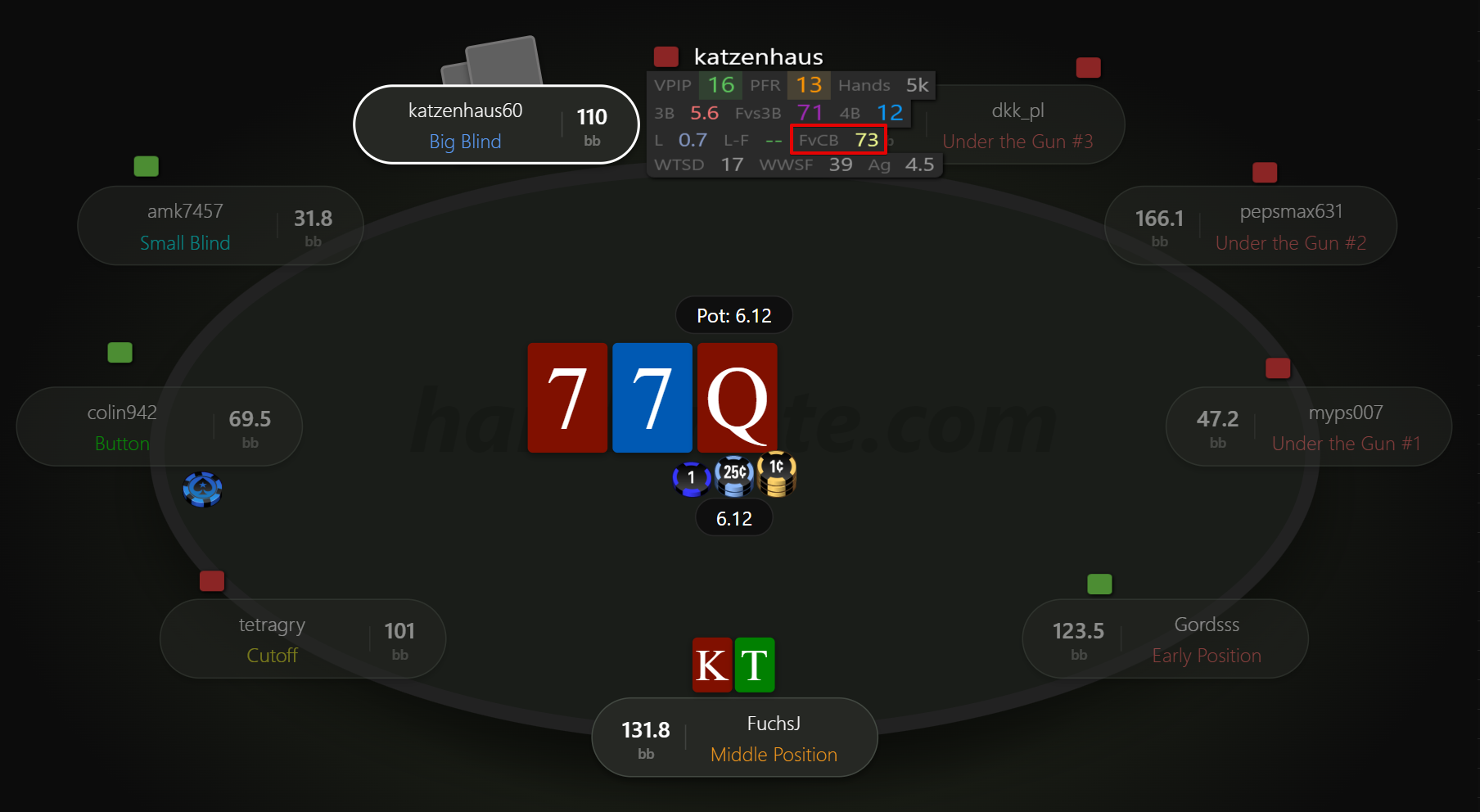
We made an open raise from the middle position with KT offsuit, and the opponent in the Big Blind called, then checked on the flop.
We missed the flop: we don’t have a pair or a strong draw. Does it mean it's better to just give up and wait for a better situation? Of course not!
The HUD of Hand2Note 4 shows that our opponent folds to a continuation bet on the flop 73% of the time, which is almost 3 times out of 4. This information is sufficient to make a bluff c-bet and try to take down the pot here and now.
# How often your opponent folds to the second barrel
Many players dislike folding to a flop c-bet, but then often surrender to the second barrel on the turn. This tendency can and should be exploited as well.
It’s not advisable to fire two streets with complete air. It’s better to apply a semi-bluff and choose hands that have the potential to make a strong combination. This way, you’ll have the chance to win the pot if the bluff doesn’t work.
Your bluffing strategy in this situation is as follows: first, you build the pot with a continuation bet on the flop, and then you take it down with the second barrel on the turn. In practice, it looks like this:
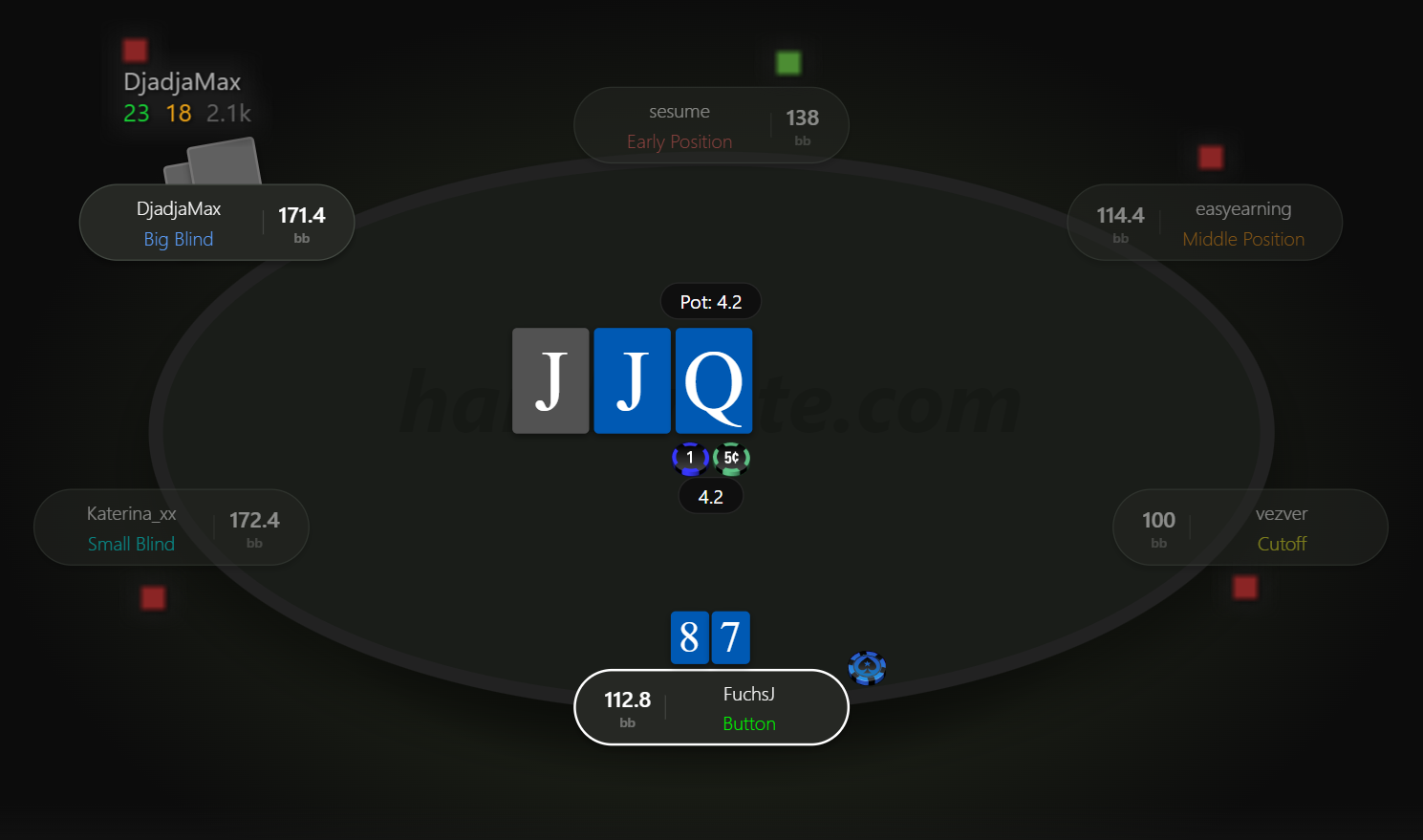
We opened with 87 suited from the Button and received a call from the player in the Big Blind. On the flop, our opponent checked, and now we need to decide how to play our flush draw. We have two options: make a continuation bet to try to force our opponent out of the pot, or check and attempt to improve on the turn.
To choose the optimal strategy, let’s open the pop-up on our opponent and study their tendencies:
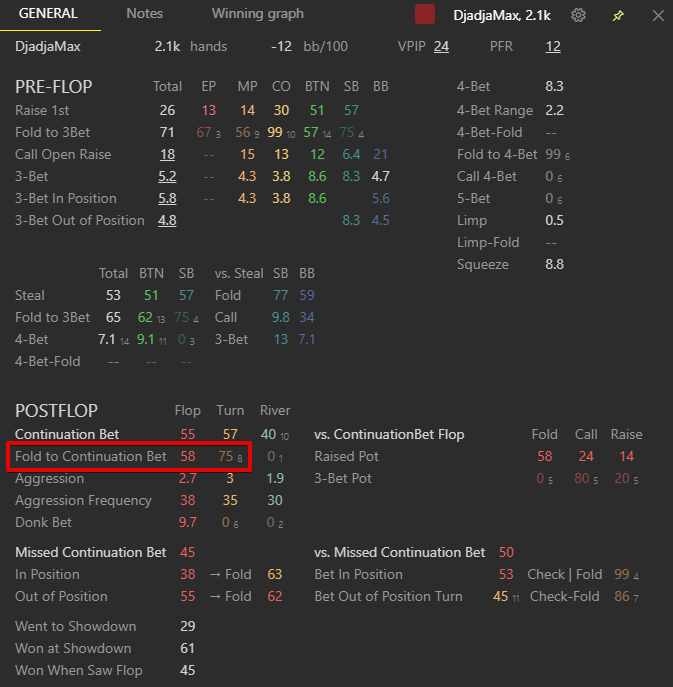
In the pop-up, we see that the player in the Big Blind folds to a continuation bet on the flop 58% of the time, making a continuation bet already profitable. More notably, after calling on the flop, our opponent folded to the second barrel on the turn 75% of the time, or 6 out of 8 occasions.
Seeing such statistics, I would definitely prefer to make a c-bet on the flop with a plan to fire the second barrel on any turn card. Even if the opponent doesn’t fold on the flop or turn, we still have the opportunity to improve to a flush on the river.
# Position on the flop
Most players tend to resist more on the flop when they are in position, and conversely, act more straightforwardly when out of position.
To see how the positional factor affects the frequency with which players fold to a continuation bet on the flop, let’s delve into the multi-player reports in Hand2Note 4. This specific feature allows you to accurately identify trends among similarly styled players and develop effective exploitative strategies against them.
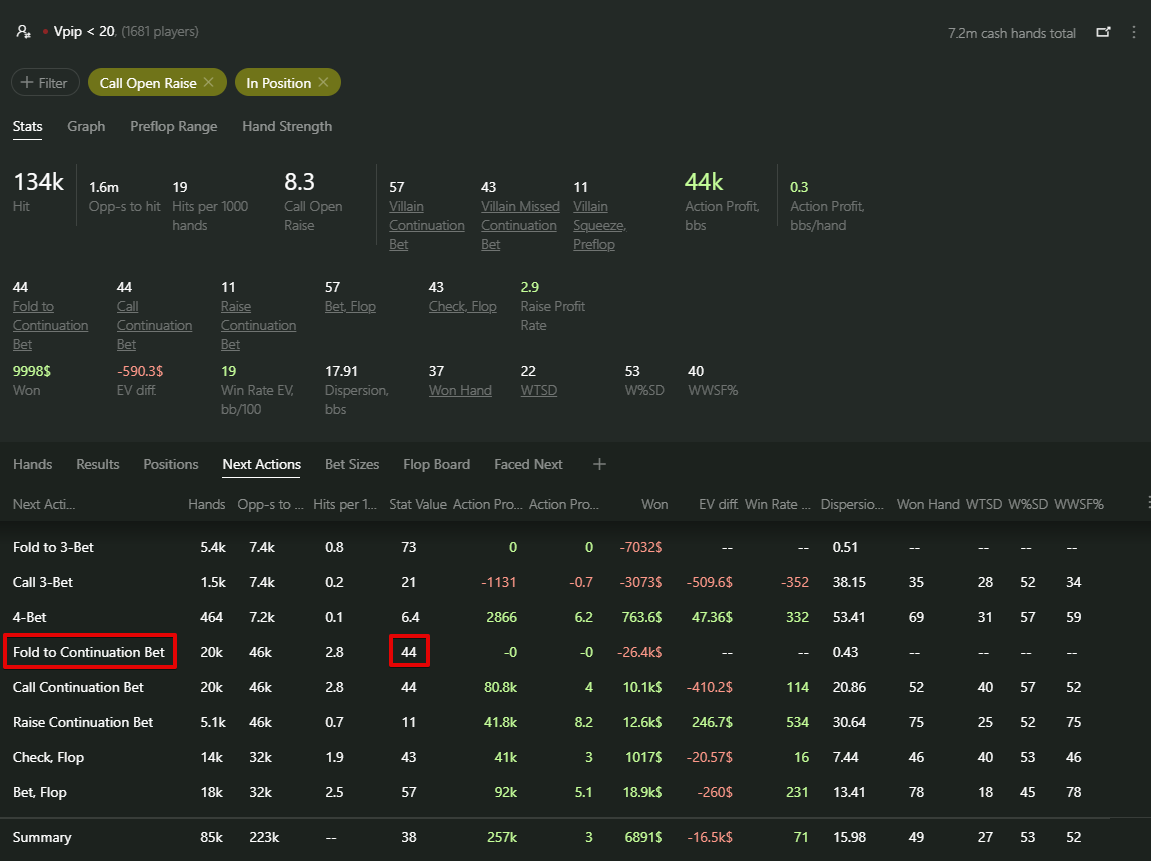
For the report, I selected tight regular players with a VPIP stat of no more than 20%. To ensure a more reliable sample, I set a condition that each player in my database should have a minimum of 1000 hands. Then, using filters, I set up the spot where a player called an open raise preflop and was in position on the flop.
By clicking on the “Next Actions” tab, we can see that, when in position, tight players folded to a continuation bet on the flop in 44% of cases, meaning not too frequently.
Now, let’s pin the current report, generate a similar one for situations where these players were on the flop out of position, and compare the reports side by side:
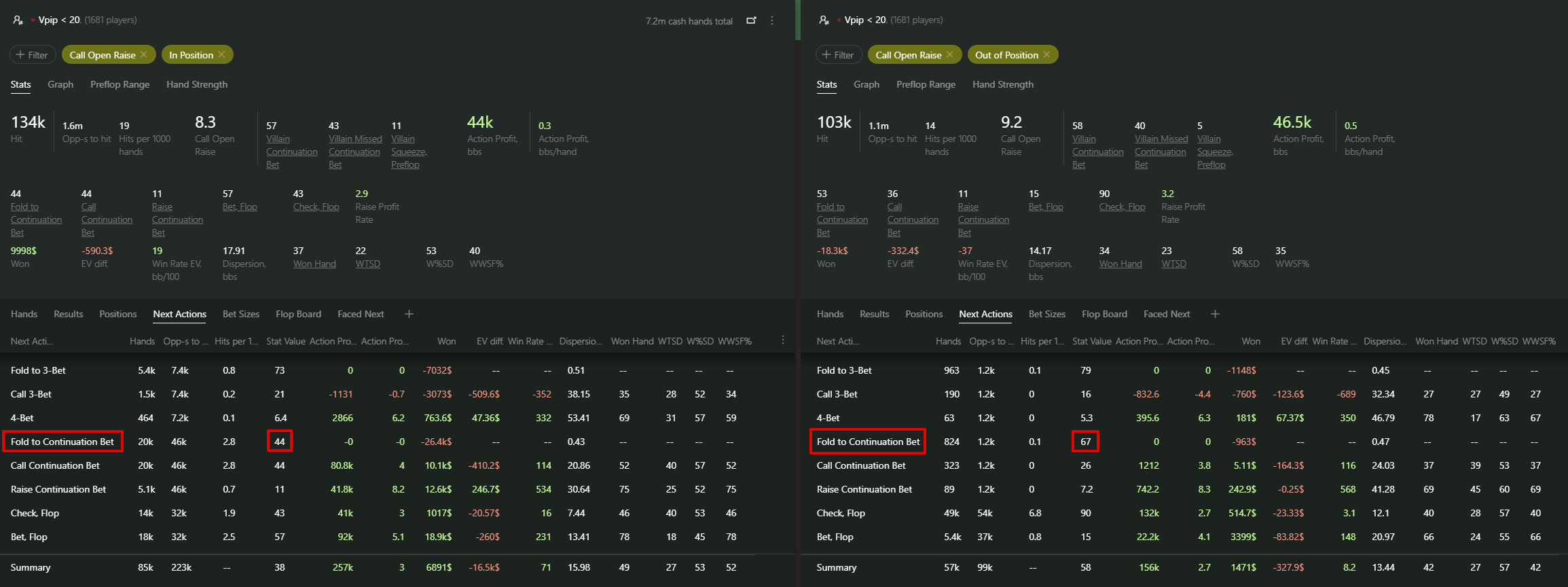
As we can see, players tend to fold more frequently, encountering a continuation bet when they are out of position, precisely in 67% of cases, or 2 times out of 3.
Given this, you should lean towards employing a bluff c-bet more often in situations where the positional advantage is in your favor. However, without position, it’s prudent to refrain from bluffing with hands that won’t improve on the subsequent streets.
# Continuation bet size
When c-bet bluffing on the flop, it is crucial to choose an appropriate bet size. If the bet is too small, the opponent may not fold, and your bluff won’t be effective.
Let’s once again utilize the multi-player reports in Hand2Note 4 and track how players react to different bet sizes:

For the report, I used the same sample as in the previous example. This time, I didn’t include the position factor on the flop in the filters because it’s not relevant in this case.
The reports navigation in Hand2Note 4 is designed to allow you to swiftly move between related situations and notice patterns in your opponents’ play. Clicking on the “Fold to Continuation Bet” stat brings up another report on the right, describing the situation when a player folded to a continuation bet on the flop.
Then, by clicking on the “Bet Sizes” tab in the new report, we observe a linear principle: the larger the size of the continuation bet on the flop, the more often players fold.
Therefore, when executing a bluff c-bet, it’s better to make a larger bet. However, you don’t necessarily have to overbet, making the bluff excessively expensive. A bet around 3/4 of the pot will apply enough pressure on your opponent and will be profitable in the long run.
# Board texture
When the flop is dealt, in addition to opponent statistics, it’s crucial to analyze the board texture and assess whom it favors more - you or your opponent.
For you as a preflop raiser, favorable textures for a c-bet include boards with an Ace and high cards, such as AK7 or AQ5.
On such flops, your range will contain more strong hands like top set, two pair, and top pair with a top kicker than your opponent’s range. This is because, with hands like AA, KK, QQ, or AK, your opponent would likely have made a preflop re-raise instead of just calling.
Let’s get back to our report and examine how often opponents fold to a c-bet on different board textures:

In the smart reports of Hand2Note 4, all the valuable information is always at your fingertips. Clicking on the “Flop Board” tab, we observe that players fold to a continuation bet 53% of the time on a rainbow dry board with an Ace and a high card, while on a middling wet board, it’s only 43%.
Thus, the better the board texture aligns with your preflop raising range, the more likely you’ll be able to take down the pot immediately on the flop.
A continuation bet on the flop as a bluff is a simple yet powerful tool, and you undoubtedly should include it in your arsenal. Understanding players’ tendencies and utilizing Hand2Note 4 to analyze your opponents’ statistics will enable you to skillfully apply this technique and achieve great success at the poker table.
# 5 Components of Successful Bluff Continuation Betting on the Flop
One of the most commonly employed poker moves is the bluff continuation bet on the flop.
In this article, we will explore five key factors that will allow you to use bluff c-bets on the flop most effectively.
Table of Contents:
- Flop fold to c-bet frequency
- How often your opponent folds to the second barrel
# Flop fold to c-bet frequency
When planning a bluff c-bet, your primary focus should be on how often your opponent folds when facing a flop C-bet. This situation is reflected in the 'Flop Fold to Continuation Bet' stat, which should be prominently displayed in your main HUD.
The higher the value of this indicator, the greater the likelihood that your bluff will be successful, allowing you to take down the pot on the flop. Let’s consider an example:

We made an open raise from the middle position with KT offsuit, and the opponent in the Big Blind called, then checked on the flop.
We missed the flop: we don’t have a pair or a strong draw. Does it mean it's better to just give up and wait for a better situation? Of course not!
The HUD of Hand2Note 4 shows that our opponent folds to a continuation bet on the flop 73% of the time, which is almost 3 times out of 4. This information is sufficient to make a bluff c-bet and try to take down the pot here and now.
# How often your opponent folds to the second barrel
Many players dislike folding to a flop c-bet, but then often surrender to the second barrel on the turn. This tendency can and should be exploited as well.
It’s not advisable to fire two streets with complete air. It’s better to apply a semi-bluff and choose hands that have the potential to make a strong combination. This way, you’ll have the chance to win the pot if the bluff doesn’t work.
Your bluffing strategy in this situation is as follows: first, you build the pot with a continuation bet on the flop, and then you take it down with the second barrel on the turn. In practice, it looks like this:

We opened with 87 suited from the Button and received a call from the player in the Big Blind. On the flop, our opponent checked, and now we need to decide how to play our flush draw. We have two options: make a continuation bet to try to force our opponent out of the pot, or check and attempt to improve on the turn.
To choose the optimal strategy, let’s open the pop-up on our opponent and study their tendencies:

In the pop-up, we see that the player in the Big Blind folds to a continuation bet on the flop 58% of the time, making a continuation bet already profitable. More notably, after calling on the flop, our opponent folded to the second barrel on the turn 75% of the time, or 6 out of 8 occasions.
Seeing such statistics, I would definitely prefer to make a c-bet on the flop with a plan to fire the second barrel on any turn card. Even if the opponent doesn’t fold on the flop or turn, we still have the opportunity to improve to a flush on the river.
# Position on the flop
Most players tend to resist more on the flop when they are in position, and conversely, act more straightforwardly when out of position.
To see how the positional factor affects the frequency with which players fold to a continuation bet on the flop, let’s delve into the multi-player reports in Hand2Note 4. This specific feature allows you to accurately identify trends among similarly styled players and develop effective exploitative strategies against them.

For the report, I selected tight regular players with a VPIP stat of no more than 20%. To ensure a more reliable sample, I set a condition that each player in my database should have a minimum of 1000 hands. Then, using filters, I set up the spot where a player called an open raise preflop and was in position on the flop.
By clicking on the “Next Actions” tab, we can see that, when in position, tight players folded to a continuation bet on the flop in 44% of cases, meaning not too frequently.
Now, let’s pin the current report, generate a similar one for situations where these players were on the flop out of position, and compare the reports side by side:

As we can see, players tend to fold more frequently, encountering a continuation bet when they are out of position, precisely in 67% of cases, or 2 times out of 3.
Given this, you should lean towards employing a bluff c-bet more often in situations where the positional advantage is in your favor. However, without position, it’s prudent to refrain from bluffing with hands that won’t improve on the subsequent streets.
# Continuation bet size
When c-bet bluffing on the flop, it is crucial to choose an appropriate bet size. If the bet is too small, the opponent may not fold, and your bluff won’t be effective.
Let’s once again utilize the multi-player reports in Hand2Note 4 and track how players react to different bet sizes:

For the report, I used the same sample as in the previous example. This time, I didn’t include the position factor on the flop in the filters because it’s not relevant in this case.
The reports navigation in Hand2Note 4 is designed to allow you to swiftly move between related situations and notice patterns in your opponents’ play. Clicking on the “Fold to Continuation Bet” stat brings up another report on the right, describing the situation when a player folded to a continuation bet on the flop.
Then, by clicking on the “Bet Sizes” tab in the new report, we observe a linear principle: the larger the size of the continuation bet on the flop, the more often players fold.
Therefore, when executing a bluff c-bet, it’s better to make a larger bet. However, you don’t necessarily have to overbet, making the bluff excessively expensive. A bet around 3/4 of the pot will apply enough pressure on your opponent and will be profitable in the long run.
# Board texture
When the flop is dealt, in addition to opponent statistics, it’s crucial to analyze the board texture and assess whom it favors more - you or your opponent.
For you as a preflop raiser, favorable textures for a c-bet include boards with an Ace and high cards, such as AK7 or AQ5.
On such flops, your range will contain more strong hands like top set, two pair, and top pair with a top kicker than your opponent’s range. This is because, with hands like AA, KK, QQ, or AK, your opponent would likely have made a preflop re-raise instead of just calling.
Let’s get back to our report and examine how often opponents fold to a c-bet on different board textures:

In the smart reports of Hand2Note 4, all the valuable information is always at your fingertips. Clicking on the “Flop Board” tab, we observe that players fold to a continuation bet 53% of the time on a rainbow dry board with an Ace and a high card, while on a middling wet board, it’s only 43%.
Thus, the better the board texture aligns with your preflop raising range, the more likely you’ll be able to take down the pot immediately on the flop.
A continuation bet on the flop as a bluff is a simple yet powerful tool, and you undoubtedly should include it in your arsenal. Understanding players’ tendencies and utilizing Hand2Note 4 to analyze your opponents’ statistics will enable you to skillfully apply this technique and achieve great success at the poker table.















